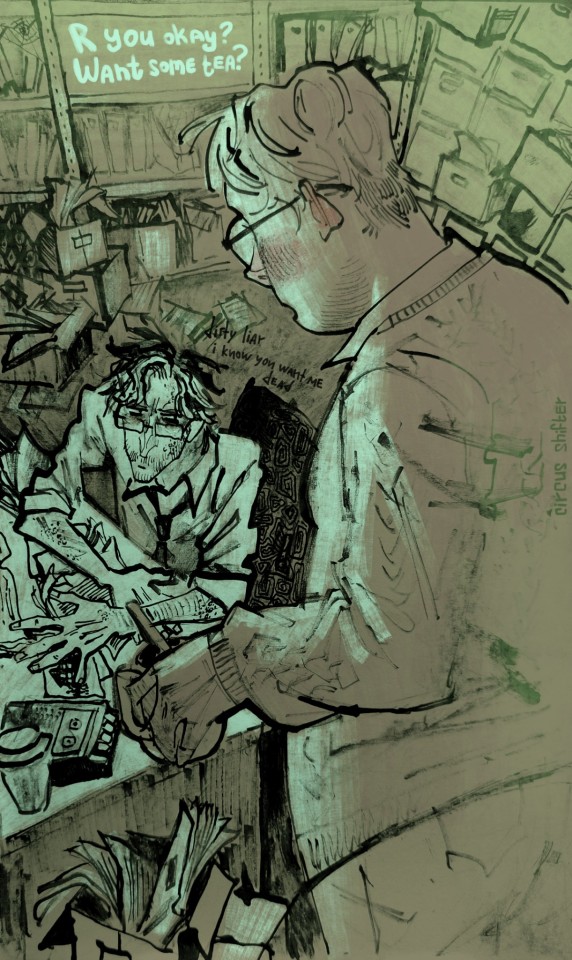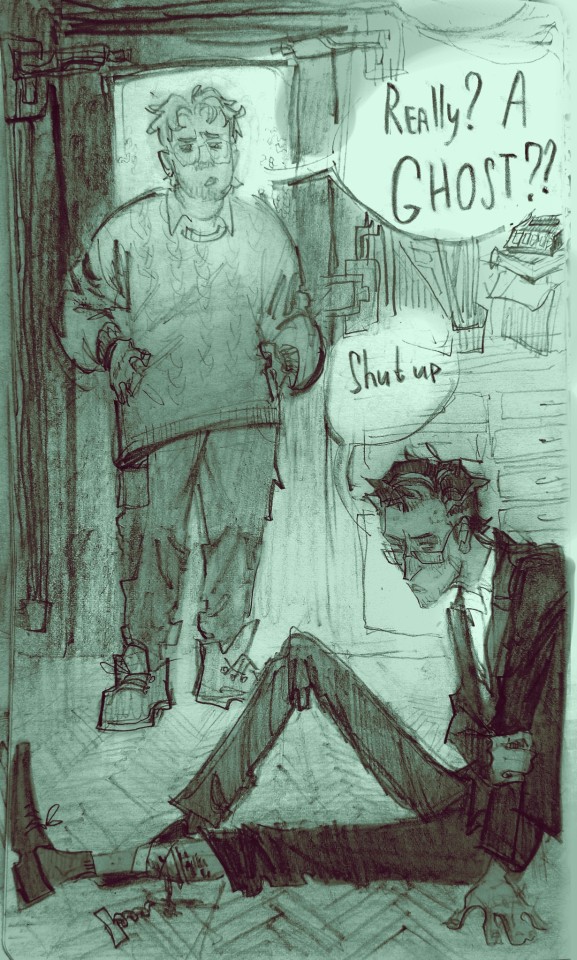Reeddiereed - Reeddie



More Posts from Reeddiereed and Others

A Cheap Imitation of You
Kinda irresponsible and misleading to try to pass off your gmo designer gray wolves as an animal that has not walked this earth in 10,000 years dont’cha think



I have some weird art block and I can only draw trees and a little Snufkin. How you deal with art block? Couse I don't know what to do. Like this is how most of my sketchbook looks like right now.


Leave a note that this is not official art or screenshots :D I just got a little carried away with the rendering, while making these matching phone wallpapers/avatars. There’s so much cosmic harmony art for Jayvik, so I went for moments when they were farthest apart from each other.

She was everything ❤️
fatherless behavior
(antpelt and beetlewhisker’s designs r a collab between me and @chaoticbeimg / @slenderverse )


˖⁺。⭑˚✶ 👁️ ⭑˖⁺˚。・゚☁️ ・゚: * ✶ ⭑⁺˖
hello jon
:)









Do you think someone will remember us?
DEEP TIME was originally published as an accordion-fold comic glued into a circular shape, so the story could be read backwards and forwards from any starting panel. Physical editions of DEEP TIME printed in bright red and teal risograph are avaliable in my shop.
Moths in Disguise: these are all just harmless moths that have developed the ability to mimic wasps, bees, and/or hornets

Top Row (left to right): Eusphecia pimplaeformis and Myrmecopsis polistes; Bottom Row: Pennisetia marginatum
Moths are exceptionally skilled when it comes to mimicry, and there are hundreds of moth species that rely on that tactic as a way to protect themselves from predators. Their disguises are numerous and varied, but hymenopteran mimicry is particularly common, especially among the moths that belong to subfamily Sesiidae and family Arctiinae.

Yellowjacket-Mimicking Moths: Pseudosphex sp. (top and bottom left) and Myrmecopsis polistes (bottom right)
Some of their disguises involve more than just a physical resemblance -- there are some moths that also engage in behavioral and/or acoustic mimicry, meaning that they can imitate the specific sounds and behaviors of their hymenopteran models. In some cases, these moths are so convincing that they can even fool the actual wasps/bees that they are mimicking.
Such a detailed and intricate disguise is unusual even among mimics, and researchers believe that it developed partly as a way to trick the wasps into treating the mimic like one of their own. Wasps tend to prey upon moths (and many other insects), but they are innately non-aggressive toward their own nest-mates, which are identified by sight -- so if the moth can convincingly impersonate its model, then it can avoid being eaten by predatory wasps.

Wasp-Mimicking Moths: Pseudosphex ichneumonea (top), Myrmecopsis sp. (bottom left), and Pseudosphex sp. (bottom right)
There are many moths that can also mimic hornets, bumblebees, and carpenter bees.

Hornet-Mimicking Moths: Eusphecia pimplaeformis (top left), Sesia apiformis (bottom left), Paranthrene simulans (top right), Pennisetia marginatum (middle right), and Sphecodoptera scribai (bottom left)

Bumblebee-Mimicking Moths: Hemaris tityus (top and bottom left) and Hemaris affinis (bottom right)
Moths are some of the most talented mimics in the natural world, as illustrated by their mastery of hymenopteran mimicry. But it's not just bees, hornets, and wasps -- there are many other forms of mimicry that can be found among moths, and the resemblance is often staggering.
Moths deserve far more credit than they receive, to be honest, because they are so incredibly interesting/diverse.
Sources & More Info:
Journal of Ecology and Evolution: A Hypothesis to Explain the Accuracy of Wasp Resemblances
Frontiers in Zoology: Southeast Asian clearwing moths buzz like their model bees
Royal Society Publishing: Moving like a model: mimicry of hymenopteran flight trajectories by clearwing moths of Southeast Asian rainforests
-
 manic-zombie liked this · 3 weeks ago
manic-zombie liked this · 3 weeks ago -
 adageyer liked this · 3 weeks ago
adageyer liked this · 3 weeks ago -
 jetsrutt liked this · 3 weeks ago
jetsrutt liked this · 3 weeks ago -
 lunarelysian liked this · 3 weeks ago
lunarelysian liked this · 3 weeks ago -
 calcar liked this · 3 weeks ago
calcar liked this · 3 weeks ago -
 freaklittlefandomblog reblogged this · 3 weeks ago
freaklittlefandomblog reblogged this · 3 weeks ago -
 starvy reblogged this · 3 weeks ago
starvy reblogged this · 3 weeks ago -
 pogrzeb-serc reblogged this · 3 weeks ago
pogrzeb-serc reblogged this · 3 weeks ago -
 wings0faraven liked this · 3 weeks ago
wings0faraven liked this · 3 weeks ago -
 welcomeeggsbenedict reblogged this · 3 weeks ago
welcomeeggsbenedict reblogged this · 3 weeks ago -
 welcomeeggsbenedict liked this · 3 weeks ago
welcomeeggsbenedict liked this · 3 weeks ago -
 moongirl0305 liked this · 3 weeks ago
moongirl0305 liked this · 3 weeks ago -
 quiescentwaffle liked this · 4 weeks ago
quiescentwaffle liked this · 4 weeks ago -
 pandamime reblogged this · 4 weeks ago
pandamime reblogged this · 4 weeks ago -
 pandamime liked this · 4 weeks ago
pandamime liked this · 4 weeks ago -
 el-the-arthole liked this · 4 weeks ago
el-the-arthole liked this · 4 weeks ago -
 cartooonlover liked this · 4 weeks ago
cartooonlover liked this · 4 weeks ago -
 multifandombullshitbabes reblogged this · 4 weeks ago
multifandombullshitbabes reblogged this · 4 weeks ago -
 thistlesissel liked this · 4 weeks ago
thistlesissel liked this · 4 weeks ago -
 repeteplays73 liked this · 4 weeks ago
repeteplays73 liked this · 4 weeks ago -
 coolname2 liked this · 4 weeks ago
coolname2 liked this · 4 weeks ago -
 eklipsecipher liked this · 4 weeks ago
eklipsecipher liked this · 4 weeks ago -
 literallymichaelafton liked this · 4 weeks ago
literallymichaelafton liked this · 4 weeks ago -
 a-sunset-outside-my-window liked this · 4 weeks ago
a-sunset-outside-my-window liked this · 4 weeks ago -
 timtamtictac liked this · 4 weeks ago
timtamtictac liked this · 4 weeks ago -
 toomanyassassins reblogged this · 4 weeks ago
toomanyassassins reblogged this · 4 weeks ago -
 whatisforlunch liked this · 4 weeks ago
whatisforlunch liked this · 4 weeks ago -
 renewashere liked this · 4 weeks ago
renewashere liked this · 4 weeks ago -
 wormspoodle liked this · 4 weeks ago
wormspoodle liked this · 4 weeks ago -
 bowloart liked this · 4 weeks ago
bowloart liked this · 4 weeks ago -
 porsiesdemadrugada liked this · 4 weeks ago
porsiesdemadrugada liked this · 4 weeks ago -
 boomposhpow reblogged this · 4 weeks ago
boomposhpow reblogged this · 4 weeks ago -
 boomposhpow liked this · 4 weeks ago
boomposhpow liked this · 4 weeks ago -
 sponery reblogged this · 4 weeks ago
sponery reblogged this · 4 weeks ago -
 dykeshitt liked this · 4 weeks ago
dykeshitt liked this · 4 weeks ago -
 acricketcannot liked this · 4 weeks ago
acricketcannot liked this · 4 weeks ago -
 freshwinnerkingdom liked this · 1 month ago
freshwinnerkingdom liked this · 1 month ago -
 nukuome liked this · 1 month ago
nukuome liked this · 1 month ago -
 thegodofteeth liked this · 1 month ago
thegodofteeth liked this · 1 month ago -
 yavannah liked this · 1 month ago
yavannah liked this · 1 month ago -
 dravenxivuk reblogged this · 1 month ago
dravenxivuk reblogged this · 1 month ago -
 sworbl liked this · 1 month ago
sworbl liked this · 1 month ago -
 versailercat liked this · 1 month ago
versailercat liked this · 1 month ago -
 cryptid-on-a-string liked this · 1 month ago
cryptid-on-a-string liked this · 1 month ago -
 dizaster-of-a-guhy liked this · 1 month ago
dizaster-of-a-guhy liked this · 1 month ago -
 tripleatechie liked this · 1 month ago
tripleatechie liked this · 1 month ago -
 perplexed-vulture liked this · 1 month ago
perplexed-vulture liked this · 1 month ago


